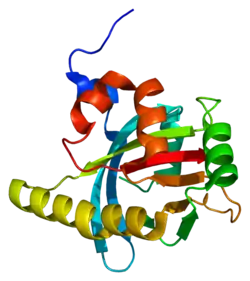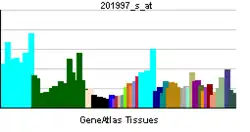SPEN
Белок, взаимодействующий с Msx2 — белок, кодируемый у человека геном SPEN .[1][2][3]
Этот ген кодирует гормон, индуцируемый репрессором транскрипции. Репрессия транскрипции продукта этого гена может произойти в результате взаимодействия с другими репрессорами, благодаря рекрутированию белков, участвующих в дезацетилировании гистонов, или путём поглощения транскрипционных активаторов. Продукт этого гена содержит карбоксильно-концевой домен, который позволяет связывание с другими белками корепрессора. Этот домен также позволяет взаимодействие с членами комплекса NuRD, нуклеосомного комплекса белкового ремоделирования, который содержит активные деацетилазы. Кроме того, этот репрессор содержит несколько мотивов распознавания РНК, которые позволяют связывание с стероидным рецептором коактиватора РНК; это связывание может модулировать активность как лигандных, так и нелигандных стероидных рецепторов.[3]
Взаимодействия
SPEN, как было выявлено, взаимодействует с HDAC1,[4] SRA1[2] и корепрессором ядерных рецепторов 2.[2]
Примечания
- Newberry E.P., Latifi T., Towler D.A. The RRM domain of MINT, a novel Msx2 binding protein, recognizes and regulates the rat osteocalcin promoter (англ.) // Biochemistry : journal. — 1999. — September (vol. 38, no. 33). — P. 10678—10690. — doi:10.1021/bi990967j. — PMID 10451362.
- Shi Y., Downes M., Xie W., Kao H.Y., Ordentlich P., Tsai C.C., Hon M., Evans R.M. Sharp, an inducible cofactor that integrates nuclear receptor repression and activation (англ.) // Genes Dev : journal. — 2001. — May (vol. 15, no. 9). — P. 1140—1151. — doi:10.1101/gad.871201. — PMID 11331609.
- Entrez Gene: SPEN spen homolog, transcriptional regulator (Drosophila).
- Shi, Y; Downes M., Xie W., Kao H Y., Ordentlich P., Tsai C C., Hon M., Evans R M. Sharp, an inducible cofactor that integrates nuclear receptor repression and activation (англ.) // Genes Dev. : journal. — United States, 2001. — May (vol. 15, no. 9). — P. 1140—1151. — ISSN 0890-9369. — doi:10.1101/gad.871201. — PMID 11331609.
Литература
- Ternovskaia L.N., Prokhorova L.G., Moroz V.M. [Antagonistic interrelationships between the staphylococci and Sarcina isolated from the upper respiratory tracts of virtually healthy persons] (англ.) // Antibiotiki : journal. — 1977. — Vol. 21, no. 12. — P. 1072—1075. — PMID 1020939.
- Nagase T., Ishikawa K., Suyama M., et al. Prediction of the coding sequences of unidentified human genes. XIII. The complete sequences of 100 new cDNA clones from brain which code for large proteins in vitro. (англ.) // DNA Res. : journal. — 1999. — Vol. 6, no. 1. — P. 63—70. — doi:10.1093/dnares/6.1.63. — PMID 10231032.
- Shi Y., Hon M., Evans R.M. The peroxisome proliferator-activated receptor delta, an integrator of transcriptional repression and nuclear receptor signaling. (англ.) // Proceedings of the National Academy of Sciences of the United States of America : journal. — 2002. — Vol. 99, no. 5. — P. 2613—2618. — doi:10.1073/pnas.052707099. — PMID 11867749.
- Oswald F., Kostezka U., Astrahantseff K., et al. SHARP is a novel component of the Notch/RBP-Jkappa signalling pathway. (англ.) // EMBO J. : journal. — 2002. — Vol. 21, no. 20. — P. 5417—5426. — doi:10.1093/emboj/cdf549. — PMID 12374742.
- Ariyoshi M., Schwabe J.W. A conserved structural motif reveals the essential transcriptional repression function of Spen proteins and their role in developmental signaling. (англ.) // Genes Dev. : journal. — 2003. — Vol. 17, no. 15. — P. 1909—1920. — doi:10.1101/gad.266203. — PMID 12897056.
- Ota T., Suzuki Y., Nishikawa T., et al. Complete sequencing and characterization of 21,243 full-length human cDNAs. (англ.) // Nat. Genet. : journal. — 2004. — Vol. 36, no. 1. — P. 40—5. — doi:10.1038/ng1285. — PMID 14702039.
- Dotzlaw H., Papaioannou M., Moehren U., et al. Agonist-antagonist induced coactivator and corepressor interplay on the human androgen receptor. (англ.) // Mol. Cell. Endocrinol. : journal. — 2004. — Vol. 213, no. 1. — P. 79—85. — doi:10.1016/j.mce.2003.10.036. — PMID 15062576.
- Beausoleil S.A., Jedrychowski M., Schwartz D., et al. Large-scale characterization of HeLa cell nuclear phosphoproteins. (англ.) // Proceedings of the National Academy of Sciences of the United States of America : journal. — 2004. — Vol. 101, no. 33. — P. 12130—12135. — doi:10.1073/pnas.0404720101. — PMID 15302935.
- Vadlamudi R.K., Manavathi B., Singh R.R., et al. An essential role of Pak1 phosphorylation of SHARP in Notch signaling. (англ.) // Oncogene : journal. — 2005. — Vol. 24, no. 28. — P. 4591—4596. — doi:10.1038/sj.onc.1208672. — PMID 15824732.
- Li J., Wang J., Yang X., et al. The Spen homolog Msx2-interacting nuclear target protein interacts with the E2 ubiquitin-conjugating enzyme UbcH8. (англ.) // Mol. Cell. Biochem. : journal. — 2007. — Vol. 288, no. 1—2. — P. 151—157. — doi:10.1007/s11010-006-9131-9. — PMID 16583136.
- Gregory S.G., Barlow K.F., McLay K.E., et al. The DNA sequence and biological annotation of human chromosome 1. (англ.) // Nature : journal. — 2006. — Vol. 441, no. 7091. — P. 315—321. — doi:10.1038/nature04727. — PMID 16710414.
- Lim J., Hao T., Shaw C., et al. A protein-protein interaction network for human inherited ataxias and disorders of Purkinje cell degeneration. (англ.) // Cell : journal. — Cell Press, 2006. — Vol. 125, no. 4. — P. 801—814. — doi:10.1016/j.cell.2006.03.032. — PMID 16713569.
- Beausoleil S.A., Villén J., Gerber S.A., et al. A probability-based approach for high-throughput protein phosphorylation analysis and site localization. (англ.) // Nat. Biotechnol. : journal. — 2006. — Vol. 24, no. 10. — P. 1285—1292. — doi:10.1038/nbt1240. — PMID 16964243.
- Olsen J.V., Blagoev B., Gnad F., et al. Global, in vivo, and site-specific phosphorylation dynamics in signaling networks. (англ.) // Cell : journal. — Cell Press, 2006. — Vol. 127, no. 3. — P. 635—648. — doi:10.1016/j.cell.2006.09.026. — PMID 17081983.
- Feng Y., Bommer G.T., Zhai Y., et al. Drosophila split ends homologue SHARP functions as a positive regulator of Wnt/beta-catenin/T-cell factor signaling in neoplastic transformation. (англ.) // Cancer Res. : journal. — 2007. — Vol. 67, no. 2. — P. 482—491. — doi:10.1158/0008-5472.CAN-06-2314. — PMID 17234755.

